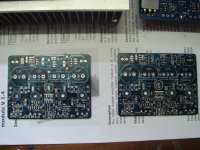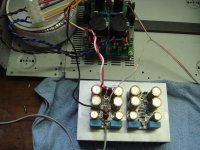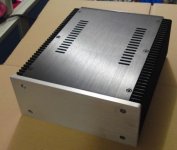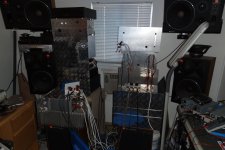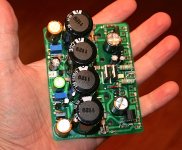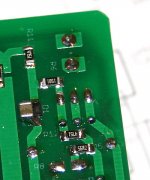Minor update...
I thought I'd post an update on my progress and to keep this thread alive a little longer....
A few days ago I took a TGM8 board, power supply and bundle of wiring to my dad's house to test it with a pair of high end loudspeakers, and to get an opinion of a second set of ears. After 90 minutes of critical listening with a range of music we both agreed it sounded very good indeed, in all its monophonic glory 😀 All testing was with the capacitor multiplier.
So I've decided to assemble a pair of new boards and make a "proper" enclosed amplifier for my living room (the P3A is now relegated to my daughter's bedroom...)
While I wait for an order to arrive with essential parts, I started soldering the SMT components with the surplus from the previous order.
Progress kinda stalled a couple days ago when the replacement VAS transistors arrived for my VSSA that's been on hold for a while. With the new transistors in and the heatsink drilled and tapped, calibrations made, I wired it up to a power supply for a quick listening test. Too early to draw any definitive conclusions; however, my initial feeling is that, in terms of sonics, the two designs have a lot in common. I suspect the VSSA has even more detail and depth in the midrange, while the TGM8 definitely has more body and depth in the bass region. They are both exciting and dynamic amplifiers that turn a brief 15 minute listening session into an hour long one. To my ears the TGM8 retains the P3A's smooth character in the upper octaves that matches nicely to the ribbon tweeters in my living room speakers.
I thought I'd post an update on my progress and to keep this thread alive a little longer....
A few days ago I took a TGM8 board, power supply and bundle of wiring to my dad's house to test it with a pair of high end loudspeakers, and to get an opinion of a second set of ears. After 90 minutes of critical listening with a range of music we both agreed it sounded very good indeed, in all its monophonic glory 😀 All testing was with the capacitor multiplier.
So I've decided to assemble a pair of new boards and make a "proper" enclosed amplifier for my living room (the P3A is now relegated to my daughter's bedroom...)
While I wait for an order to arrive with essential parts, I started soldering the SMT components with the surplus from the previous order.
Progress kinda stalled a couple days ago when the replacement VAS transistors arrived for my VSSA that's been on hold for a while. With the new transistors in and the heatsink drilled and tapped, calibrations made, I wired it up to a power supply for a quick listening test. Too early to draw any definitive conclusions; however, my initial feeling is that, in terms of sonics, the two designs have a lot in common. I suspect the VSSA has even more detail and depth in the midrange, while the TGM8 definitely has more body and depth in the bass region. They are both exciting and dynamic amplifiers that turn a brief 15 minute listening session into an hour long one. To my ears the TGM8 retains the P3A's smooth character in the upper octaves that matches nicely to the ribbon tweeters in my living room speakers.
Attachments
Very interesting. Looks like LC's modules? Surprising that the bass is better on the P3A. Both my VSSA amps have great, punchy bass. You have piqued my interest in the P3A.
I have those Cap Multipliers in three of my amps. Great little PSU.
Blessings, Terry
I have those Cap Multipliers in three of my amps. Great little PSU.
Blessings, Terry
Member
Joined 2009
Paid Member
You're having a lot of fun with those amps !
I also noticed the bass was good on the TGM8, in fact I was a bit suspicious it might be better than on my TGM7 (SKA GB150 clone).
It would be interesting to compare the P3a with multiplier vs the TGM8 without - does the TGM8 benefit from it ?
From what I have learned from Hugh, I believe the mid range can be affected by the nested feedback (R8) as he included it on some of his designs because he liked what it did for the mids. Do you have R8 installed ? you could try removing it, and you could try halving it's value.
I also noticed the bass was good on the TGM8, in fact I was a bit suspicious it might be better than on my TGM7 (SKA GB150 clone).
It would be interesting to compare the P3a with multiplier vs the TGM8 without - does the TGM8 benefit from it ?
From what I have learned from Hugh, I believe the mid range can be affected by the nested feedback (R8) as he included it on some of his designs because he liked what it did for the mids. Do you have R8 installed ? you could try removing it, and you could try halving it's value.
Terry,
Yes - they are LC's modules.
I wouldn't say the P3A has better bass than the VSSA: quite the opposite in my opinion. However my preliminary conclusion is that TGM8 has more body and depth in the bass than VSSA.
TGM8 and VSSA have a similar sound. TGM8 also shares some of P3A's best traits, namely the smooth, refined treble that matches so well with my loudspeakers.
Terry, if you are only going to build one of the two, I highly recommend you consider the TGM8 if your soldering skills are up-to-scratch. Knowing you, you'll probably end up building both - and then some 😀
The Mr Evil / PMI cap multipliers are great. I regret not getting more boards!
Gareth,
I have a second P3A board that is a permanent fixture in my workshop that I've used to try out all sorts of things.
I've tested the P3A with the cap multiplier and to be honest it didn't make a lot of improvement over a modest CRC filtered supply. In fact the 'best' bass was probably achieved with a CRC supply with generous "C" (10mF?) after the "R".
I never had any dramas with high frequency artefacts effecting the P3A, like I did with the TGM8, which were resolved once I substituted the cap multiplier. I know you have said that the PSRR is better with TGM8; however, my (albeit limited) experience is that it needs a quality supply to achieve the best result. The gains with P3A are not nearly as significant.
Gareth, the more time I spend with TGM8 the more impressed I am. Having now heard the VSSA, I am equally impressed and it is deserving of the high praise it is getting around here. But your design is in the same league: similar in many respects and subtly different in others. I suspect TGM8 will better suit my tastes but will reserve judgement until I've spent time with both.
Would be interested in your views on TGM7 vs. TGM8. What attracted me to the P3A is its simplicity and Rod's ethos of "stability is paramount". The SKA GB150 schematic is more complex and my reading from your TGM7 thread and others is that its quite difficult to stabilise. I suppose if there is a sonic improvement then those compromises may be justified - but even then I'm not sure. What is your favourite TGM amp at the moment?
Yes - they are LC's modules.
I wouldn't say the P3A has better bass than the VSSA: quite the opposite in my opinion. However my preliminary conclusion is that TGM8 has more body and depth in the bass than VSSA.
TGM8 and VSSA have a similar sound. TGM8 also shares some of P3A's best traits, namely the smooth, refined treble that matches so well with my loudspeakers.
Terry, if you are only going to build one of the two, I highly recommend you consider the TGM8 if your soldering skills are up-to-scratch. Knowing you, you'll probably end up building both - and then some 😀
The Mr Evil / PMI cap multipliers are great. I regret not getting more boards!
Gareth,
I have a second P3A board that is a permanent fixture in my workshop that I've used to try out all sorts of things.
I've tested the P3A with the cap multiplier and to be honest it didn't make a lot of improvement over a modest CRC filtered supply. In fact the 'best' bass was probably achieved with a CRC supply with generous "C" (10mF?) after the "R".
I never had any dramas with high frequency artefacts effecting the P3A, like I did with the TGM8, which were resolved once I substituted the cap multiplier. I know you have said that the PSRR is better with TGM8; however, my (albeit limited) experience is that it needs a quality supply to achieve the best result. The gains with P3A are not nearly as significant.
Gareth, the more time I spend with TGM8 the more impressed I am. Having now heard the VSSA, I am equally impressed and it is deserving of the high praise it is getting around here. But your design is in the same league: similar in many respects and subtly different in others. I suspect TGM8 will better suit my tastes but will reserve judgement until I've spent time with both.
Would be interested in your views on TGM7 vs. TGM8. What attracted me to the P3A is its simplicity and Rod's ethos of "stability is paramount". The SKA GB150 schematic is more complex and my reading from your TGM7 thread and others is that its quite difficult to stabilise. I suppose if there is a sonic improvement then those compromises may be justified - but even then I'm not sure. What is your favourite TGM amp at the moment?
Hi Ranchi,
Thanks for the review. I have always wondered about the P3A. My first build was the P101. Being a musician, I always thought a lot of power was necessary for good sound so when Rod's designs were recommended I went with his high powered amp. It wasn't until I built the Symasym, that I learned that it doesn't' take a lot of power to get a great sound. I have been following this thread with interest. I have boards for the nx, FetZilla and Struth's Blameless coming so I will be busy for a while but this one is in my radar.
Blessings, Terry
Thanks for the review. I have always wondered about the P3A. My first build was the P101. Being a musician, I always thought a lot of power was necessary for good sound so when Rod's designs were recommended I went with his high powered amp. It wasn't until I built the Symasym, that I learned that it doesn't' take a lot of power to get a great sound. I have been following this thread with interest. I have boards for the nx, FetZilla and Struth's Blameless coming so I will be busy for a while but this one is in my radar.
Blessings, Terry
Member
Joined 2009
Paid Member
Hi Christian,
I am fascinated by this PSRR question, your observations are the reverse of their theoretical performance but glad to hear you are enjoying the sound of them both. I would love to hear your thoughts on the impact on sound of the TGM8 from some tweaking of R8 as mentioned, and/or the compensation caps etc.
TGM7 vs TGM8 - well first I need to get a proper volume control wired up so I can compare the amps with a decent source, I'll be diving into my parts bin shortly 😀
Hi Terry,
I have read reports on this forum I think, where some folk have preferred the P3A over the P101 so you may want to give it a try. Also, given that you find ultimate power isn't the most important factor you should try a tube amplifier one of these days.
I am fascinated by this PSRR question, your observations are the reverse of their theoretical performance but glad to hear you are enjoying the sound of them both. I would love to hear your thoughts on the impact on sound of the TGM8 from some tweaking of R8 as mentioned, and/or the compensation caps etc.
TGM7 vs TGM8 - well first I need to get a proper volume control wired up so I can compare the amps with a decent source, I'll be diving into my parts bin shortly 😀
Hi Terry,
I have read reports on this forum I think, where some folk have preferred the P3A over the P101 so you may want to give it a try. Also, given that you find ultimate power isn't the most important factor you should try a tube amplifier one of these days.
Last edited:
Hi Gareth,
Now that I am running out of transformers, I may give tube amps a try. My only experience with tube amps have been my guitar and bass amps. Of course with those I wanted distortion.
I hadn't played the P101 for a while and then recently I was A/Bing all my amps and hooked it up. It was the closest to the SKA in sound of all my amps. I should use if more but I am always listening to my most recent builds. I just have too many amps for most of them to get much play time. Going to have to find homes for some of them.
Blessings, Terry
Now that I am running out of transformers, I may give tube amps a try. My only experience with tube amps have been my guitar and bass amps. Of course with those I wanted distortion.
I hadn't played the P101 for a while and then recently I was A/Bing all my amps and hooked it up. It was the closest to the SKA in sound of all my amps. I should use if more but I am always listening to my most recent builds. I just have too many amps for most of them to get much play time. Going to have to find homes for some of them.
Blessings, Terry
Member
Joined 2009
Paid Member
Hi Terry,
Now that's interesting - the P101 and SKA are both MOSFET output and they sound similar. Mind you, they use quite different types of MOSFETs. I also remember you saying the SKA treble was closest to your Class A KSA 50 amplifier.
Tube amps are an interesting thing but they can be a bit more expensive to build. I have parts to make a nice mono 2A3 amp lying around somewhere.
Anyhow, I already decided that the TGM8 and the TGM7 are 'keepers' and I've ordered new boxes to build them into. Actually, I have ordered 4 boxes like the one shown in the photo, only with a black front panels instead of silver coloured. So I'll have an incentive to properly finish up and make a good job of a total of 4 different amplifiers of the Class AB type. I've already chosen two of them. I don't think I have the shelf space for as many amps as you have !
The boxes probably won't be here for another 3 - 4 weeks though.
Now that's interesting - the P101 and SKA are both MOSFET output and they sound similar. Mind you, they use quite different types of MOSFETs. I also remember you saying the SKA treble was closest to your Class A KSA 50 amplifier.
Tube amps are an interesting thing but they can be a bit more expensive to build. I have parts to make a nice mono 2A3 amp lying around somewhere.
Anyhow, I already decided that the TGM8 and the TGM7 are 'keepers' and I've ordered new boxes to build them into. Actually, I have ordered 4 boxes like the one shown in the photo, only with a black front panels instead of silver coloured. So I'll have an incentive to properly finish up and make a good job of a total of 4 different amplifiers of the Class AB type. I've already chosen two of them. I don't think I have the shelf space for as many amps as you have !
The boxes probably won't be here for another 3 - 4 weeks though.
Attachments
Hi Gareth,
Yes I did say that the SKA was close to the KSA50 but then I tried the P101 and I think that is closer. To be honest, once you equalize the volume, it is very hard to distinguish between two different amps. The VSSA and Blameless directives "seem" to have just a bit more detail especially in the mid region than the SKA, P101 and Krells. That is not always a better thing depending on what you are listening to. However, sometimes it is amazing what you can hear going on in front of the mic.
Anyway, you have a gift for explaining things and I have learned a lot from reading your posts. Like I said, I already have a few amps in line to build so it will be awhile before I get a chance to try a tube amp but I'm sure I will get to one eventually.
I don't have shelf space per say. I have a huge stack of Diamond plated goodness. 😀
Yes I did say that the SKA was close to the KSA50 but then I tried the P101 and I think that is closer. To be honest, once you equalize the volume, it is very hard to distinguish between two different amps. The VSSA and Blameless directives "seem" to have just a bit more detail especially in the mid region than the SKA, P101 and Krells. That is not always a better thing depending on what you are listening to. However, sometimes it is amazing what you can hear going on in front of the mic.
Anyway, you have a gift for explaining things and I have learned a lot from reading your posts. Like I said, I already have a few amps in line to build so it will be awhile before I get a chance to try a tube amp but I'm sure I will get to one eventually.
I don't have shelf space per say. I have a huge stack of Diamond plated goodness. 😀
Attachments
Hi guys...
Gareth, I have R8 (= 470k) fitted to all the boards. I haven't tried removing it or changing the value but will experiment with it at some point.
Many of the changes I've made to P3A and TGM8 have had no audible impact on sound quality. Other times there is a subtle difference but it is not immediately apparent whether the difference is an improvement or not. I like to work methodically, making a change at a time, and making small changes to component values - so this is to be expected.
The biggest improvement to the single-pole comp TGM8 was to reduce the miller cap to ~68p from the 100p that I started with (the same value Rod Elliott specifies). Reducing it below 56p did subtly change the character of the sound but it wasn't an 'improvement'. I wondered if this was the onset of instability I was hearing so I settled on 68p in the end. I've tried 22p and 33p for lead compensation but can't hear any difference whatsoever. I have wondered if this component is superfluous (you won't find it on Rod's schematic) and considered removing it altogether.
I haven't played around with compensation on the two-pole board, mainly because (a) a trial and error approach involving listening tests is going to be rather time consuming; (b) you've already fine tuned this on the 'scope.
I've only listened to two pole using your original recommendations of 33p and 330p for C4 and C6, respectively. Interesting, during my A-B testing with my "optimised" single pole board, I couldn't find any sonic differences. Boards #3 and #4 are being built with your updated values of 22p and 100p for C4 and C6, respectively. I'll report back with my observations.
Most of the changes you can only hear with good quality loudspeakers in a comfortable listening environment - I save the red wine until after all testing is completed - promise 😀 So that means carting equipment back and forth to the workshop to make tweaks. Its kinda laborious and time consuming so you have to pick your battles by focusing on the things you feel are important.
Gareth, I have R8 (= 470k) fitted to all the boards. I haven't tried removing it or changing the value but will experiment with it at some point.
Many of the changes I've made to P3A and TGM8 have had no audible impact on sound quality. Other times there is a subtle difference but it is not immediately apparent whether the difference is an improvement or not. I like to work methodically, making a change at a time, and making small changes to component values - so this is to be expected.
The biggest improvement to the single-pole comp TGM8 was to reduce the miller cap to ~68p from the 100p that I started with (the same value Rod Elliott specifies). Reducing it below 56p did subtly change the character of the sound but it wasn't an 'improvement'. I wondered if this was the onset of instability I was hearing so I settled on 68p in the end. I've tried 22p and 33p for lead compensation but can't hear any difference whatsoever. I have wondered if this component is superfluous (you won't find it on Rod's schematic) and considered removing it altogether.
I haven't played around with compensation on the two-pole board, mainly because (a) a trial and error approach involving listening tests is going to be rather time consuming; (b) you've already fine tuned this on the 'scope.
I've only listened to two pole using your original recommendations of 33p and 330p for C4 and C6, respectively. Interesting, during my A-B testing with my "optimised" single pole board, I couldn't find any sonic differences. Boards #3 and #4 are being built with your updated values of 22p and 100p for C4 and C6, respectively. I'll report back with my observations.
Most of the changes you can only hear with good quality loudspeakers in a comfortable listening environment - I save the red wine until after all testing is completed - promise 😀 So that means carting equipment back and forth to the workshop to make tweaks. Its kinda laborious and time consuming so you have to pick your battles by focusing on the things you feel are important.
Gareth,
Those are very nice cases. Are they the Modushop ones? My living room P3A is in one that looks very similar.
Terry,
I followed Struth's Blameless thread with interest and downloaded the final schematic, layout and build notes. This appears to be in the true "blameless" style with all of Self's bells and whistles. I seriously considered getting some boards made but decided after the DX MKIII that I wouldn't build another such high power amp again. May I ask where you acquired the boards for this project?
I went downstairs earlier to fire up the VSSA again, this time with a pair of floor standers, to confirm whether my initial suspicions were correct. This amp *does* have tremendous midrange clarity, and I suspect when I get the second channel finished and the unit upstairs, it will impress with its stereo imaging and depth of sound stage also.
I wish someone would do a low/mid power Blameless VFA design with all the bells and whistles. That would be an interesting study.
Those are very nice cases. Are they the Modushop ones? My living room P3A is in one that looks very similar.
Terry,
I followed Struth's Blameless thread with interest and downloaded the final schematic, layout and build notes. This appears to be in the true "blameless" style with all of Self's bells and whistles. I seriously considered getting some boards made but decided after the DX MKIII that I wouldn't build another such high power amp again. May I ask where you acquired the boards for this project?
I went downstairs earlier to fire up the VSSA again, this time with a pair of floor standers, to confirm whether my initial suspicions were correct. This amp *does* have tremendous midrange clarity, and I suspect when I get the second channel finished and the unit upstairs, it will impress with its stereo imaging and depth of sound stage also.
I wish someone would do a low/mid power Blameless VFA design with all the bells and whistles. That would be an interesting study.
Member
Joined 2009
Paid Member
Hi Terry - you have quite an impressive collection there !
Hi Ranchu32,
It is a busy time when you are comparing amps - the wine certainly makes the listening tests more accurate 😀
I found this box on eBay: 2109 Full Aluminum Power Amplifier Enclosure | eBay
I decided there isn't enough to warrant a pcb change so I kitted the parts for another TGM8 channel and spend this afternoon building it. Building the 2nd board was nice as I could incorporate what I learned from the 1st board which made it easier and better. It's not quite finished yet. See attached photo. I will eventually use it to try a different R8 and for that I want two channels so I can compare side-by-side. The BOM I followed is attached.
By the way, I might be interested in doing a mid power blameless VFA with some bells and whistles. The reason is that these 4 boxes I've ordered are to represent the results of my foray into Class AB. I have built a few amps which were based on the blameless (TGM1, TGM2 & TGM6) yet none of them are really in a great final form so I am attracted to the idea of spinning up a new one for the '3rd box'. I have found it very handy to have the speaker protection and power rail caps on-board (thanks to some encouragement by folk on this thread), perhaps I could re-use much of the TGM8 layout to make a blameless ?
Hi Ranchu32,
It is a busy time when you are comparing amps - the wine certainly makes the listening tests more accurate 😀
I found this box on eBay: 2109 Full Aluminum Power Amplifier Enclosure | eBay
I decided there isn't enough to warrant a pcb change so I kitted the parts for another TGM8 channel and spend this afternoon building it. Building the 2nd board was nice as I could incorporate what I learned from the 1st board which made it easier and better. It's not quite finished yet. See attached photo. I will eventually use it to try a different R8 and for that I want two channels so I can compare side-by-side. The BOM I followed is attached.
By the way, I might be interested in doing a mid power blameless VFA with some bells and whistles. The reason is that these 4 boxes I've ordered are to represent the results of my foray into Class AB. I have built a few amps which were based on the blameless (TGM1, TGM2 & TGM6) yet none of them are really in a great final form so I am attracted to the idea of spinning up a new one for the '3rd box'. I have found it very handy to have the speaker protection and power rail caps on-board (thanks to some encouragement by folk on this thread), perhaps I could re-use much of the TGM8 layout to make a blameless ?
Attachments
Last edited:
I tried to think up some enhancements to justify another run of boards. Was going to ask whether it would be difficult to add another pair of MOSFETs to allow higher voltage/power but decided that was silly.
Its pretty much perfect within the 10x10cm space constraints. I don't think there is room to add anything, and there isn't any reason to take away. The problems with the current boards are negligible anyhow.
That photo is interesting and is pretty much how I expect my next pair of stereo boards to look once fully stuffed!
Its pretty much perfect within the 10x10cm space constraints. I don't think there is room to add anything, and there isn't any reason to take away. The problems with the current boards are negligible anyhow.
That photo is interesting and is pretty much how I expect my next pair of stereo boards to look once fully stuffed!
Gareth,
Those are very nice cases. Are they the Modushop ones? My living room P3A is in one that looks very similar.
Terry,
I followed Struth's Blameless thread with interest and downloaded the final schematic, layout and build notes. This appears to be in the true "blameless" style with all of Self's bells and whistles. I seriously considered getting some boards made but decided after the DX MKIII that I wouldn't build another such high power amp again. May I ask where you acquired the boards for this project?
I went downstairs earlier to fire up the VSSA again, this time with a pair of floor standers, to confirm whether my initial suspicions were correct. This amp *does* have tremendous midrange clarity, and I suspect when I get the second channel finished and the unit upstairs, it will impress with its stereo imaging and depth of sound stage also.
I wish someone would do a low/mid power Blameless VFA design with all the bells and whistles. That would be an interesting study.
Hi Christian,
Kevin sent me the Gerbers just before he uploaded them to his website. I ordered some boards from a PCB company. I should have them in a week or two. I ordered extra since they had a minimum. Once I build on eof the boards and know they work I will probably sell the extras to anyone interested. I wasn't going to build any more high powered amps but I have a 67-0-67vac transformer from an old Soundcraftsmen amp so this will be a chance to use it. Anyway, I don't want to take this thread off track. Looking forward to hearing more about the TGM8.
You have better ears than me if you can judge an amp by only listening to half a stereo image. Fools me every time.
Blessings, Terry
Last edited:
Member
Joined 2009
Paid Member
You have better ears than me if you can judge an amp by only listening to half a stereo image. Fools me every time.
That's a good point - you know, I got so used to mono that I am beginning to prefer it and find stereo can sometimes sound a bit 'false' - the fault of the recording perhaps.
By the way, that's going to be a powerful amp if you use that trafo.
So far me and my friends, all being in audio with some serious commercial equipment, could not trace the amp revealing so much info, like words meaning-understanding, some hidden background details revealed in a polite way, etc., ... the closest we came with some tube amps like Kronzila or Audio Research or similar multi k$ units.I went downstairs earlier to fire up the VSSA again, this time with a pair of floor standers, to confirm whether my initial suspicions were correct. This amp *does* have tremendous midrange clarity, and I suspect when I get the second channel finished and the unit upstairs, it will impress with its stereo imaging and depth of sound stage also.

Member
Joined 2009
Paid Member
I'm quite suspicious of having this zener diode without direct bypass cap - I think it can make a subtle difference to the background noise level. So here I simply added a chip capacitor in parallel with the zener diode (D1). The photo shows just after soldering so still messy with flux - an 'action shot' 🙂
Attachments
Thanks Bigun.... keep the updates coming. I'm still soldering the new boards, but only finding 10-15 mins a day, which is slowing progress.
Can I use a regular 100n X7R or does it need to be a NP0 dielectric?
Can I use a regular 100n X7R or does it need to be a NP0 dielectric?
Member
Joined 2009
Paid Member
Can I use a regular 100n X7R or does it need to be a NP0 dielectric?
where are you using it ?
- Home
- Amplifiers
- Solid State
- TGM8 - my best amplifier, incredible bass, clear highs, no fatigue (inspired by Rod Elliot P3a)
